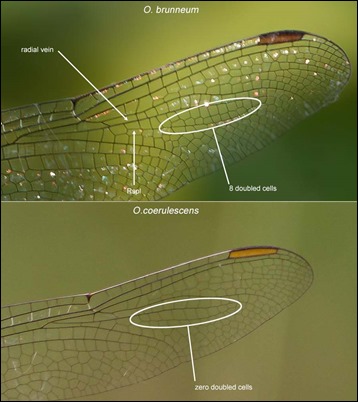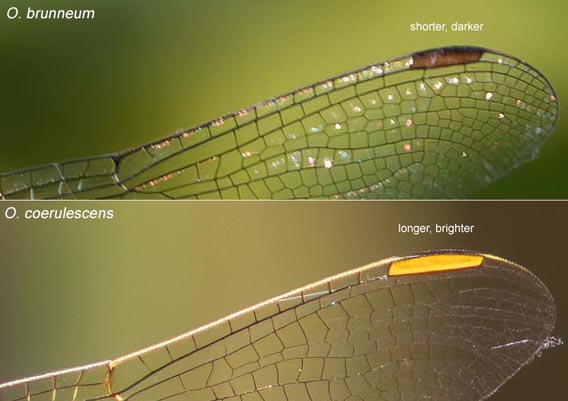[I am indebted to Tony (Ant) Marriot for his picture of a female Southern Skimmer (Orthetrum brunneum) used below … with thanks.]
Within the European theatre there are two painfully similar Skimmer (Orthetrum) species, the Keeled Skimmer (Orthetrum coerulescens) and the Southern Skimmer (Orthetrum brunneum). The latter does not yet occur in the British Isles and to my knowledge there have not yet been any sightings of vagrants in Britain, so this article is more of interest to those who visit the continent. O. brunneum is, however, on the northern coast of France, though it is less common there than it is further south, but given the changing climate, who knows in the near-ish future?
There are a number of distinguishing features used in identification. Some of these features are gender neutral whilst others are specific to gender and/or maturity. The features are not always as cut and dried as they might be so bear discussion. The images below are linked to larger versions which are easier to decipher.
Gender neutral
Wing venation
Above the Rspl of the forewing there may be a variable number of doubled cells. O. coerulescens has 0 – 5 cells doubled, whereas O. brunneum has a minimum of 4 cells doubled but usually more, often 6 or more. Unfortunately that makes 4 or 5 doubled cells overlap territory and so such a count is inconclusive. Note that the number of doubled cells can vary between left and right forewings, and also in the hindwings. The specimen shown above had 6 doubled cells in the left forewing. R. R. Askew suggests that the number of doubled cells in all four wings can be a useful guide, though doesn’t quantify it.
Pterostigmas
Both species have a variation of yellow pterostigmas. However, those of O. brunneum are darker, said to be more brown than yellow. This can be tricky to assess depending on light and maturity. Size is sometimes a clearer factor in that O. coerulescens has longer pterostigmas than does O. brunneum. Comparative distinctions are always a little difficult in isolation, though.
Mature Males
Pruinosty
The males of both species develop a pale blue pruinose abdomen. Males of O. brunneum develop a pruinose thorax as well, making them blue from end to end, whereas, in the north of its range, the males of O. coerulescens do not generally develop a blue thorax. However, in the south of its range, males of O. coerulescens can develop a blue thorax making it look more like O. brunneum.
Frons
The frons is generally reliable, the frons of O. brunneum males being quite white, making it look clean and fresh whereas the frons of O. coerulescens males has a distinct brown tinge giving it more of a dirty appearance.
2ary genitalia
I mention this just for the sake of completeness, since I have no photograph to illustrate it – this is more of a hand and lens feature, though it could show up on a very detailed photograph. The 2ary genitalia of O. coerulescens is a chunkier affair than that of O. brunneum. A good field guide, such as K-D Dijkstra’s, shows the detail.
Females/Immature Males
Abdominal Markings
Both species have a thin, dark line down the centre of the dorsal side of the abdomen; this is the so-called “keel”. At the posterior of segments 3-7, O. coerulescens has a short black bar crossing the keel. In O. brunneum, this is not a bar but a pair of separate dots. Note that immature males can be more heavily marked with black than females but the feature remains.
A Conundrum
So, given all of the above, what then is this specimen, an immature female that I photographed in Provence, southern France, June 2023?
I first noticed the doubled cells above the Rspl. The right wing clearly has 5 doubled cells but the left wing appears at first sight to have 6 doubled cells. However, looking closely, the centre cell seems to be being bisected by an extra “spurious” vein. This really looks like 5 cells with the centre cell split.
Now look at the abdominal markings. S3 and S4 have a clear cross bar spanning the keel. S6 and S7 clearly have pairs of spots either side of the keel. The marking on S5 looks like a bit of a hybrid. This gives mixed signals.
So, the doubled cells are inconclusive and the abdominal markings are mixed.
Looking at the pterostigmas, they seem to be clear yellow and look quite long so, I’m pretty sure that this is O. coerulescens. A very immature O. brunneum would likely also have quite yellow pterostigmas but they wouldn’t appear that long, I think.
[Back to the abdominal markings, I have been wondering if perhaps the cross bars of O. coerulescens might develop from spots moving down the abdomen with increasing maturity but I have no literature to support that probably fanciful, off the wall idea.]







The immature one at the bottom of the page is 100% sure a Southern Skimmer. The white frons, large amount of white on the thorax and markings on the abdomen are all typical for brunneum. Also, females coerulescens have a narrow and more cilindrical abdomen.
More interesting though is the presence of several Forcipomyia paludis on the wing venation 😉
That’s a good point.